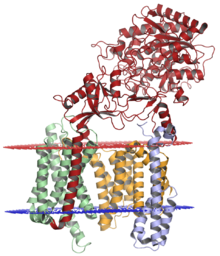| Gamma-secretase (Nicastrin subunit) | |||||||||
|---|---|---|---|---|---|---|---|---|---|
 The gamma secretase complex, with nicastrin (red), presenilin-1 (orange), PEN-2 (blue), and APH-1 (green); lumenal membrane shown in red and cytoplasmic membrane shown in blue. The structure was solved by cryo-electron microscopy.[1] | |||||||||
| Identifiers | |||||||||
| Symbol | Gamma-secretase, γ-secretase | ||||||||
| Pfam | PF05450 | ||||||||
| InterPro | IPR008710 | ||||||||
| OPM superfamily | 244 | ||||||||
| OPM protein | [ 5fn5[ | ||||||||
| Membranome | 155 | ||||||||
| |||||||||
Gamma secretase is a multi-subunit protease complex, an integral membrane protein, that cleaves single-pass transmembrane proteins at residues within the transmembrane domain. Proteases of this type are known as intramembrane proteases. The most well-known substrate of gamma secretase is amyloid precursor protein, a large integral membrane protein that, when cleaved by both gamma and beta secretase, produces a short 37-43[verification needed] amino acid peptide called amyloid beta whose abnormally folded fibrillar form is the primary component of amyloid plaques found in the brains of Alzheimer's disease patients. Gamma secretase is also critical in the related processing of several other type I integral membrane proteins, such as Notch,[2] ErbB4,[3] E-cadherin,[4] N-cadherin,[5] ephrin-B2,[6] or CD44.[7]
- ^ Bai, Xiao-chen; Yan, Chuangye; Yang, Guanghui; Lu, Peilong; Ma, Dan; Sun, Linfeng; Zhou, Rui; Scheres, Sjors H. W.; Shi, Yigong (17 August 2015). "An atomic structure of human γ-secretase". Nature. 525 (7568): 212–217. doi:10.1038/nature14892. PMC 4568306. PMID 26280335.
- ^ De Strooper B, Annaert W, Cupers P, Saftig P, Craessaerts K, Mumm JS, Schroeter EH, Schrijvers V, Wolfe MS, Ray WJ, Goate A, Kopan R (1999). "A presenilin-1-dependent gamma-secretase-like protease mediates release of Notch intracellular domain". Nature. 398 (6727): 518–22. doi:10.1038/19083. PMID 10206645. S2CID 4346474.
- ^ Ni CY, Murphy MP, Golde TE, Carpenter G (2001). "gamma -Secretase cleavage and nuclear localization of ErbB-4 receptor tyrosine kinase". Science. 294 (5549): 2179–81. doi:10.1126/science.1065412. PMID 11679632. S2CID 23227013.
- ^ Marambaud P, Shioi J, Serban G, Georgakopoulos A, Sarner S, Nagy V, Baki L, Wen P, Efthimiopoulos S, Shao Z, Wisniewski T, Robakis NK (2002). "A presenilin-1/gamma-secretase cleavage releases the E-cadherin intracellular domain and regulates disassembly of adherens junctions". EMBO J. 21 (8): 1948–56. doi:10.1093/emboj/21.8.1948. PMC 125968. PMID 11953314.
- ^ Marambaud P, Wen PH, Dutt A, Shioi J, Takashima A, Siman R, Robakis NK (2003). "A CBP binding transcriptional repressor produced by the PS1/epsilon-cleavage of N-cadherin is inhibited by PS1 FAD mutations". Cell. 114 (5): 635–45. doi:10.1016/j.cell.2003.08.008. PMID 13678586. S2CID 7265454.
- ^ Georgakopoulos A, Litterst C, Ghersi E, Baki L, Xu C, Serban G, Robakis NK (2006). "Metalloproteinase/Presenilin1 processing of ephrinB regulates EphB-induced Src phosphorylation and signaling". EMBO J. 25 (6): 1242–52. doi:10.1038/sj.emboj.7601031. PMC 1422162. PMID 16511561.
- ^ Lammich S, Okochi M, Takeda M, Kaether C, Capell A, Zimmer AK, Edbauer D, Walter J, Steiner H, Haass C (2002). "Presenilin-dependent intramembrane proteolysis of CD44 leads to the liberation of its intracellular domain and the secretion of an Abeta-like peptide". J Biol Chem. 277 (47): 44754–9. doi:10.1074/jbc.M206872200. PMID 12223485.